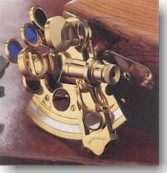In the 1600 and early 1700, no one knew how to determine the meridian of longitude at sea....
Many tried and failed including Newton, Hooke (the rubber band) , Halley (the Comet) and other very accomplished scientists. It was proclaimed to be unsolvable, until Harrison, a carpenter/mechanic, came along...
-------
To determine where you are at sea or anywhere, you need to know the latitude and the longitude of your location. The latitude tells you the north-south position relative to the equator ( there are more than one kind of latitude, but all of them are quite similar). It can be readily determined by the angle between the Sun and the horizon using an instrument called Sextant (
meaning 1/6. In Chinese it is referred to as a luk fun yee). You see them in old movies about sailing/pirates, such as caption Cooke and other seafaring heros. The Sextant has two mirrors, one fixed, one movable. In bringing the image of the sun to coincide with that of the horizon, one can measure the angle, hence the latitude. A good sextant can have a resolution of about 10 seconds, corresponding to a north/south position of within a few hundred yards or a few hundred meters.

The longitude was apparently much more difficult to determine,
since there was no easy reference point to use at sea. The approach was to figure out the local time at sea relative to Greenwich time; from the time difference one can determine the longitude at sea. Since the globe spins 360 degrees in 24 hours , if one knows the time difference between Greenwich and the ship, one would be able to know the longitude relative to Greenwich, which was set at zero degree by the Royal Observatory.
We can give an example to illustrate the point here. The time
difference between California and New York is three hours. One degree of longitude to the east, the Sun arrives 4 minutes earlier, or about 69 miles in distance along the equator. Three hours of time difference means New York is about 15 degrees east of California. The two states are, therefore, about 3000 miles apart if they were along the equator. This is a zeroth order approximation, but it does demonstrate the " time difference method " of longitude determination. (The actual air distance between San Diego and New York city is 2432 miles, since the two cities are north of the Equator). One can, of course, estimate the distance between Hong Kong and California by the same method of time difference ( - 8 hours time difference = about 8000 miles, actual air distance = 7347 miles between San Diego and Hong Kong).
There were seemingly two schools of thought on how to determine the time at sea. The astronomers favored the " Lunar distance" method, based on astronomical data and the observation of the moon at night. The combination of the two could lead to the time difference between Greenwich and the ship at sea. It was later found to be impractical, much to the dismay of the astronomers.
The other approach was to figure out the local time at sea using a very accurate clock. There were numerous difficulties to be accurate at sea due to the change of climate,
temperature, effects of vibration, wind and centrifugal force and the-like on pendulum clocks of that era.
You may well ask " what is wrong with using a Sundial to keep
accurate time at sea ?" Sundials are not good timekeepers because the Earth's orbital is not circular, the time of Sundial is sometimes ahead and sometimes behind clock time. The variation of sundial time is known as the " equation of time" and had been known to the Greeks and the Arabs many
centuries earlier.
Due to these difficulties, the Board of Longitude decided to
issue a challenge to the scientific community on how to determine the longitude to within 0.5 degree after a six-week trip at sea ( from England to Jamaica). This required a time piece accurate to 2.86 seconds per day for 6 weeks on a ship. The board was consisted of very prominent scientists, including the Lucasian, Savilian and Plumian professors of mathematics at Oxford and Cambridge.
The current Lucasian professor of mathematics at Cambridge is Stephen Hawkins. Now, you see they had some equivalent or even more prominent scientists on the Board.

 Previous
Next Previous
Next |


![]()
![]() Get
your own Free Home Page
Get
your own Free Home Page